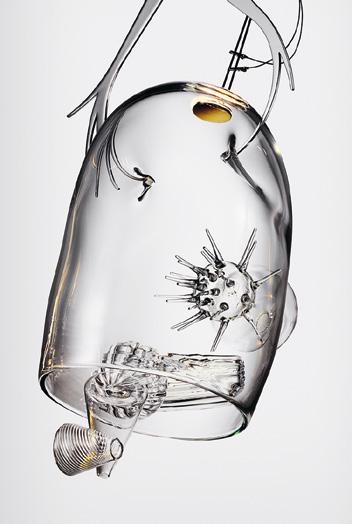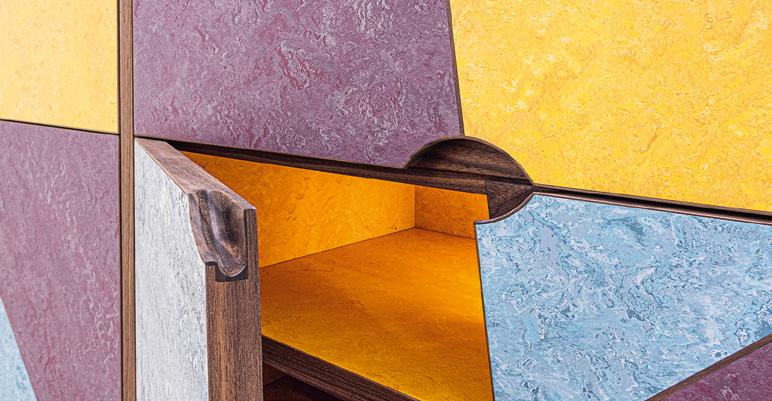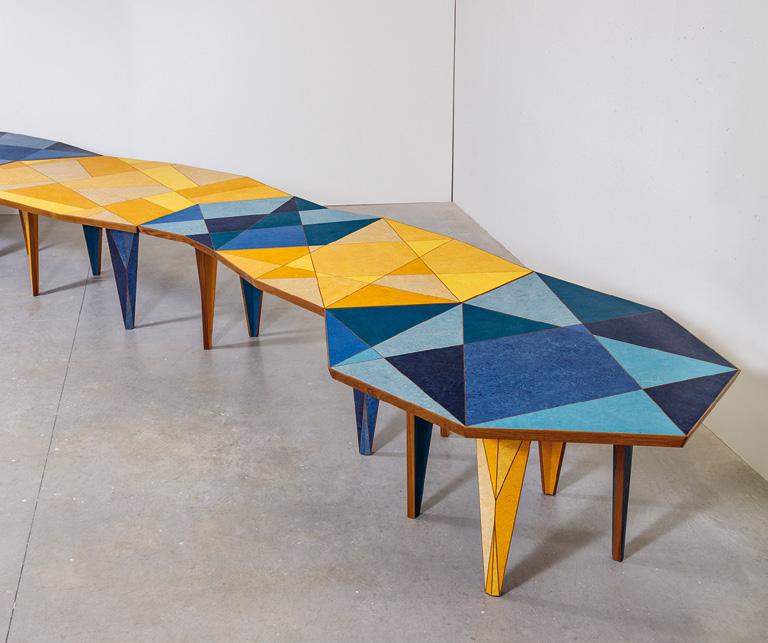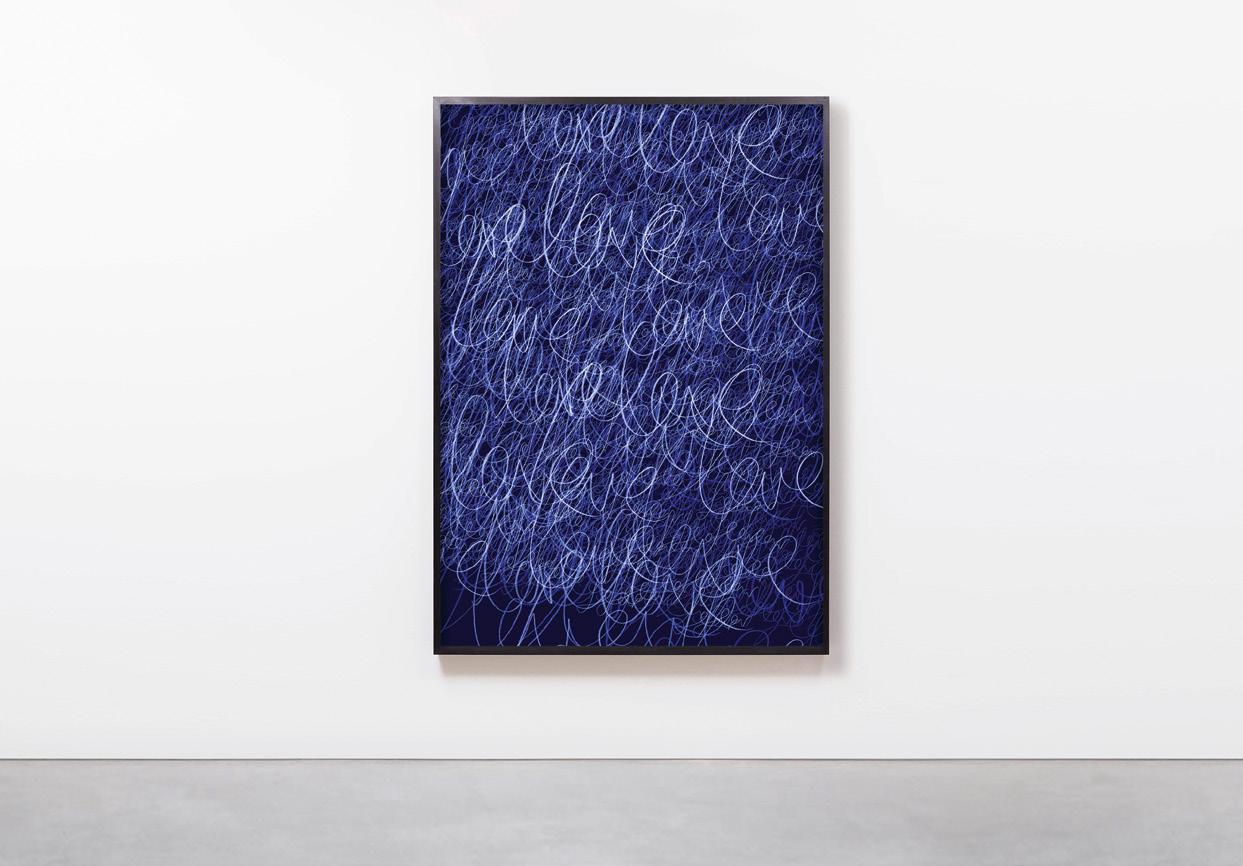8 minute read
A BURST OF BESPOKE
Photo above: Hand-finishing a chain link for Lindsey Adelman's spring 2021 collection. Photo: Nigel Cox
With more time at home, collectors across the globe are upping orders from their favorite artisans. Caroline Roux asks, is this a new golden age for private commissions?

Paradise City Caliper pendant by Lindsey Adelman.
Photo: Nigel Cox
This spring, the Brooklyn-based lighting designer Lindsey Adelman went on a ski trip to Utah with her husband and son. They didn’t leave the western state again for many weeks. “Everything turned upside down right after we arrived,” she says of her timing, “so we stayed on and did a lot of hiking.” She also created hundreds of artworks – “I did paintings incessantly; ordered watercolor paper in bulk and used it all up” – after which she decamped to the Hamptons to complete a two-year-long evolution of a lighting collection called Paradise. By midsummer, she had also received one of the biggest private commissions of her career.
In this, she is not alone. Throughout lockdown and after, contemporary design’s standout names have been receiving more requests for one-off pieces than ever before. “I found myself working with new clients in New York, the Hamptons and Berlin,” says Michael Anastassiades, the lighting and furniture designer, based in London, who is also a major player at the Italian company Flos. “It’s been extraordinary; what might have been a quiet time has actually been an exciting one, especially creatively. The New York commission is at a scale I’ve never worked at before – a mobile chandelier but of the sort of dimensions that takes things to a whole new level. Put it this way, it wouldn’t fit in my house.”

A portrait of Lindsey Adelman.
Photo: Stephen Kent Johnson
Adelman’s commission, likewise, is a room-size installation, which will necessitate 100 feet of chain to complete. While it’s not exactly the size that matters, both stories seem symptomatic of a new set of circumstances that lockdown brought to pass, not least for the wealthy. For those used to incessant travel, the enforced confinement meant more time at home (and in just one home of their several). For those with a schedule previously heaving with appointments, whether work or social, it gave the gift of uninterrupted time (or boredom – take your pick). And many apparently used that time to trawl through social media, and dig deep into designer websites, revealing new levels of unimagined possibilities and a deeper acquaintance with work by designers and artists they might have hitherto brushed past at fairs and in publications.
“I think people wanted to regain a sense of control, and for some that meant looking at their immediate surroundings,” says Martino Gamper, an Italian designer based in London and a master of materials, including wood and lino. “They wanted change.” Several of Gamper’s commissions have been for large tables – up to 4.5 meters long. “We love going out, we love restaurants,” he says. “So people started recreating that experience at home instead.”

Martino Gamper’s Off-Cut Lino Cabinet, 2020.
Photo: Christian Gufler
Another commission came via the interior designer Pamela Shamshiri for a house in the Los Angeles hills designed in the mid-20th century by Modernist architect A Quincy Jones. (Interior designers have been kept extremely busy, too.) With just a basic brief to make a five-meter-long hanging console, Gamper looked to burr elm and his favorite finish of colored lino to pay homage to the 20th-century Californian craft sensibility. The console was then made in the Italian Alps by one of Gamper’s preferred master cabinet makers, initially through remote communication. “But I was there for the final details at the end of July,” says Gamper. “It’s possible to work by Zoom, but we make physical, tactile pieces, and it’s important to have a direct relationship with the maker and the object.”

Martino Gamper’s Off-Cut Lino Table in 4 Sections, 2019.
Photo: Christian Gufler
THERE’S A MUCH STRONGER SENSE OF THE WAY THAT DESIGN ENRICHES THE WAY WE LIVE DAY TO DAY
Anastassiades agrees. “Zoom never really clicked with me. And the thing is, that when I walk into a space, I know exactly what’s needed immediately.” But lockdown led him to find a way to work with architects’ videoed walk-throughs, and the development – finally – of the one skill he’d never previously honed: remote working.
Anastassiades talks, too, about the collapse of old hierarchies of communications. “As people spent more time online, and were on Instagram 24/7, the old barriers got broken down. It has collapsed some of the hierarchical systems and removed some of the intermediate people in a discussion. Now it’s all about direct message and WhatsApp. And actually calling people on the phone. I’m currently curating a small show at the MAK in Vienna; all the pieces are from the biggest private collection of Wiener Werkstätte work. Once this would have been organized through teams of people, now I just call the director on his mobile.”
“It’s been interesting to work out how to get things done,” says Adelman, who found herself working remotely with glassmakers all over the United States for the creation of the most decorative parts of her lighting products and installations. “But makers have found so many solutions to working differently. Some were working in their living rooms, which is what I did when I was starting out. There were others making it all happen in a kitchen in Harlem, in an old woodshop in Western Massachusetts, mailing me parts from Pennsylvania.”
So did it really take a pandemic to make us appreciate where we live and what we live with? It’s not completely unreasonable to think so. “Some of the 0.0001% are actually downsizing,” says Adelman, referring to some recent conversations she’s had over the past months. “Where they had four houses, they’re talking about unloading two of them, and making the remaining ones exactly what they want. They seem to be more geared to a dream place, and with a greater sense of completeness.”

Barnaby Barford, Land of Hope & Glory, 2019.
Courtesy: David Gill Gallery
The founders of London’s Gallery FUMI, Sam Pratt and Valerio Capo, have even framed their latest exhibition around the importance of home. “We’ve been through the sort of changes this year,” say Capo and Pratt, “that make people take many things less for granted. On a domestic level, that can include a much stronger sense of the way that design enriches the way they live day to day.”
Capo and Pratt have also noticed that some of their most dedicated clients have finally made decisions that have been years in the making. “A private client in Los Angeles had been thinking about a Rowan Mersh piece for the longest time,” says Capo, about commissioning the London artist who conjures natural elements including shells and feathers into large-scale 3D wall works that create delicate shadow play. “They finally took the plunge during lockdown.”

Barnaby Barford, Love over Fear (Blue), 2020.
Courtesy: David Gill Gallery
Another London gallerist, Sarah Myerscough, also mentions “a few good commissions from our friends in the US”. After hosting a show called The Natural Room, she received requests for 10 baskets by the artist Alison Dickens (mostly from the US), while a number of commissions came through for major pieces by Peter Marigold, a London-based designer who works remotely with the master woodworker Tadanori Tazawa Kogei, who is based just north of Tokyo. One is a five-meter-long cabinet in natural wood containing shelves and a writing desk stained black; another is for a huge wardrobe, with doors made of single split logs. “They have to come in parts from Japan,” says Marigold, “because at some point they may have to go in an elevator.”
While Marigold also spent time helping out at his local restaurant, helping it move its operation successfully out onto the street, and eventually doing the odd shift, artists have coped with lockdown and
its aftermath in various ways. Barnaby Barford, who works across a range of media from film to large-scale sculpture, says, “I took my studio home with me to where I live on the outskirts of London and did lots of work on canvas and paper.” An online exhibition with his gallery, David Gill, of “word drawings” from Barford’s Truth and Lies series then translated into a surprising number of sales. “All we did was to make a very simple web page for the new work on paper,” he says, “and that seems to have encouraged people to look at my past work.” As part of this trickle-up effect, a major commission came through for one of his outsized apple sculptures for a private collection in the South of France, from an entirely new client.
Zizipho Poswa, a ceramist in Cape Town whose work takes inspiration from her own situation as a Xhosa woman in contemporary South Africa, found herself back at home too, but with no access to her studio. “We were seriously confined to our homes and I really missed the smell of clay,” she says. “I’d fired a piece just before the lockdown was declared and had left it to cool down in the kiln. Those weeks at home, wondering how it turned out, were torture. I was so tempted to go and take a peep. Returning to the studio was like a homecoming, but once we were back though, the challenge was having to complete work before the curfew started.”
“It’s true,” says her gallerist Trevyn McGowan of Southern Guild, “our government was very proactive. But we reacted swiftly at the gallery, organizing ourselves to work remotely. It allowed us to shift to a richer kind of storytelling through video and digital content, and it has meant more outreach and interaction with our clients.”
One outcome was a call from Georgina Jaffe, a local collector who is developing a collection of contemporary works celebrating the symbolic, and material, properties of southern African hair and hairstyling. Jaffe had learned about Poswa’s work from a video and has since acquired a major piece from her Magodi series. “She wanted the one named after my grandmother, Mampinga,” says Poswa. “She visits me in my dreams.”
“I feel like I’m part of an emerging community of people who have realized they don’t want to live their life in a completely exhausting way, but want to stay in touch, and to have experiences,” says Adelman. “We’re just doing it in different ways.” Ways which, it turns out, are extremely, unexpectedly, successful.
Caroline Roux is an arts writer
(Above) Barnaby Barford, Love over Fear (Blue), 2020. Courtesy: David Gill Gallery

